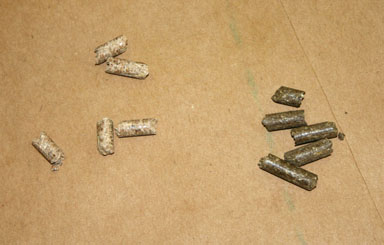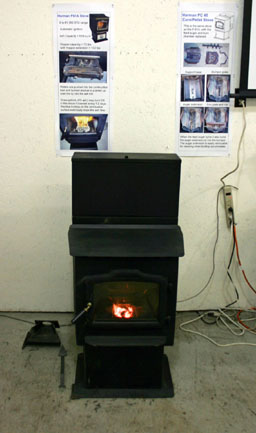March 25, 2005
Grass as biofuel
On Monday afternoon, I went to see a presentation up on Mount Pleasant that may hold some promise for both agriculture and open space in Dryden. Cornell scientists have been working with various kinds of grass, working to find ways that grass can be burned in stoves for heat or in other systems for both heat and power. Wood pellet stoves have become fairly ordinary, and grass pellets can be made using similar technology.

Wood pellets and grass pellets
About 30 people attended the meeting, including Dryden's Zoning Officer and Environmental Planner, as well as people, largely farmers, from Tompkins, Tioga, Dutchess, Steuben, Broome, and Niagara counties. Jenifer Wightman introduced the session, which started with posters and stoves running. Then Professor Jerry Cherney, a forage specialist, gave a presentation about the mechanics and economics of using grass pellets as fuel.
The good news about grass pellets is that they're not that hard to produce, can use grasses grown with minimal (or no) care or fertilization, actually do better if they're left out in the rain for a while, and don't have a negative impact on greenhouse gas generation. It may even fit better with wildlife nesting patterns than regular hay fields. It's a great way to use marginal farmland, and a way to keep land in some kind of production that might otherwise grow back to woods. It's even possible to harvest land that's been somewhat overgrown and use that material to make these pellets.
Cherney also pointed out the disadvantages, however. Stoves built for wood pellets have problems with the higher ash content of grass pellets. While there are stoves built for corn, which has somewhat similar characteristics, stove manufacturers don't presently have much interest in burning grass, though some are working with the researchers at Cornell. Similarly, Cherney said, this isn't cool biotechnology or nanotechnology, and doesn't have a political lobby backing it up, so it's hard to find the funding needed to make this practical on either the production end (where pelleting devices are needed) or the consumption end (where appropriate stoves or other burners are necessary.)
One of the problems Cherney mentioned is also an opportunity - "No one is going to make millions from this." The economics of transporting grass argues against centralized processing, though the prices for the pellets and their energy should be comparable to hay despite fewer inputs. If this works, it's likely to be a distributed process, with mobile pelletizers and small-scall permanent systems running close to the fields, supplying customers who are relatively nearby.
I don't think it would be easy to get there, but it's at least a nice idea to think of farms in Dryden using their marginal land to produce grasses, harvesting them after the hay season is over, pelletizing them, and selling them to Dryden residents who use them for affordable heat. It could be a way to keep farmland in use, and keep money flowing within the community instead of out of it.
There's a lot more information about the process and the details of making grass pellet biofuels work in their posters and slides, which I've posted as a gallery. They'll also be having another session on Saturday, April 2nd. If you're interested, contact Jeni Wightman at 255-4230 or email jw93@cornell.edu.
Posted by simonstl at March 25, 2005 06:51 PMNote on photos
